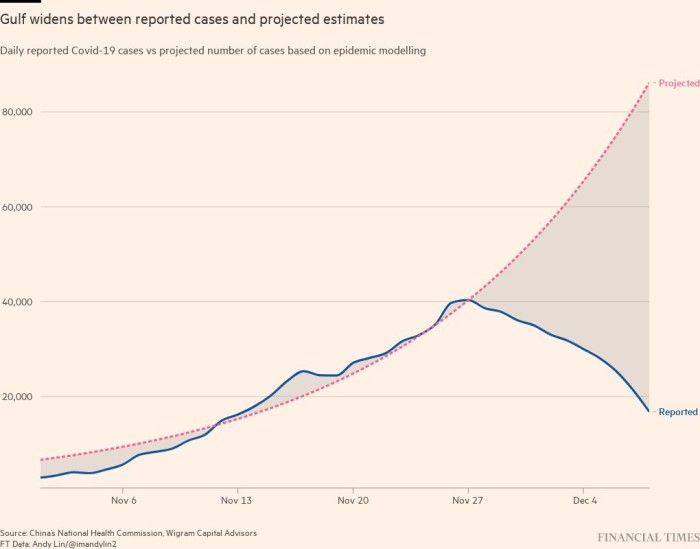China’s disappearing data stokes fears of hidden Covid wave
China is starting to under-report coronavirus cases and fatalities, which experts warn is obscuring the scale and severity of the health crisis just as the world’s most populous country enters its deadliest phase of the pandemic.
Official statistics on Friday revealed no new deaths and only 16,363 locally transmitted coronavirus cases in China, less than half the peak caseload reported last month.
That is despite a stunning U-turn over the past week to relax President Xi Jinping’s heavy-handed pandemic controls, which means the virus is certain to spread.

The situation echoes the dearth of official information during the disastrous initial outbreak in Wuhan nearly three years ago. Local officials and analysts warned that the reduced testing, as well as gaps in reporting of both cases and deaths, would make it harder to assess the risk to the world’s second-biggest economy.
“The behaviour of case numbers is very similar to 2020, where we had one [to] two weeks with genuine case numbers, before the veil was drawn,” said Rodney Jones, principal at Wigram Capital Advisors, an Asia-focused macroeconomic advisory group.

However, public anxiety is increasing about the healthcare system’s capacity to handle a big rise in Covid cases and the discrepancy between the official narrative and reality.
“We should address the problem — either report real figures or stop publishing them,” Hu Xijin, a former editor of the Global Times, a nationalist tabloid, wrote in a social media post, adding that disseminating “severely distorted figures to the public” was damaging the authority of official information.
Hospitals in Beijing have started running out of medical supplies, including ibuprofen and paracetamol, as health workers fight an outbreak spreading rapidly through the Chinese capital. Yet the Chinese capital reported just 2,654 official new infections on Friday for the day prior.
Ben Cowling, a professor of epidemiology at the University of Hong Kong, warned of the risks of abandoning testing requirements and reporting cases inaccurately.
“As testing intensity is reduced, it will be more difficult to maintain situational awareness of the level of infections in the community, and interpretation of case counts will be more nuanced,” he said.
Yanzhong Huang at the Council for Foreign Relations think-tank, noted that after the November surge in cases, there were “so many asymptomatic cases and so few severe cases”.
“That is puzzling,” he said. “Does that mean they have a different way of counting Covid-related deaths?”
Others maintained that after nearly three years, the costs of mass testing, coupled with China’s contact tracing system, had become unsustainable.
As local government coffers dried up, the decision to depart from mass testing was essentially forced upon Beijing, said Sam Radwan, principal at Enhance International, a consultancy.
“Beijing Social Insurance Fund Management Center has run out of money. They’re having a hard time paying bills for the first time in a very long time,” Radwan said, referring to the capital’s agency responsible for funding health services.
“That’s why you were seeing they’re shutting down testing booths before they’re removing the restrictions.”
Additional reporting by William Langley, Andy Lin, Gloria Li and Eleanor Olcott in Hong Kong
This story originally appeared on: Financial Times - Author:Edward White



























